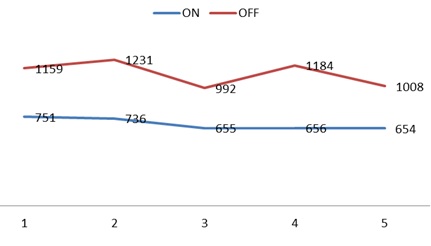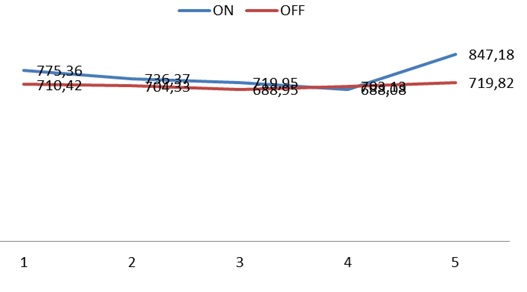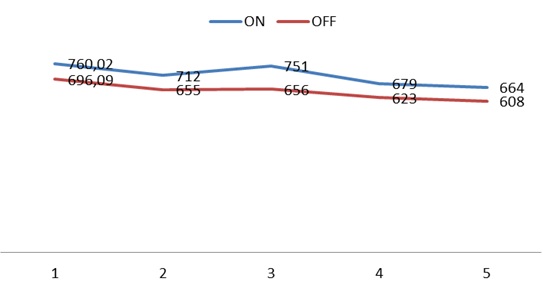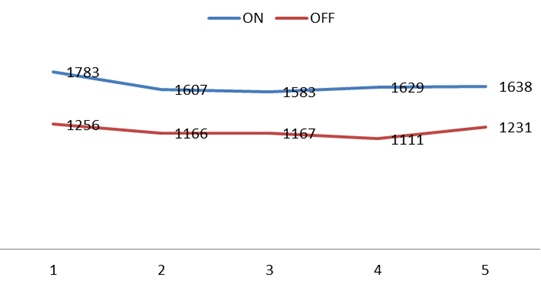Session Information
Date: Wednesday, June 7, 2017
Session Title: Parkinson's Disease: Cognition
Session Time: 1:15pm-2:45pm
Location: Exhibit Hall C
Objective: This study aims to analyze the DBS effects on the PD patients implicit learning.
Background: PD is considered the second more common neurodegenerative disease and initially, it was believed that cognition was preserved in PD, but current research brings data showing deficits in this aspect. Implicit learning is one of them and it refers to the casual or not, sometimes seemingly small, acquisition of a given event, but that can generate significant future consequences. In addition to the drug and therapeutics treatment, there is a subcortical structures electrical stimulation – DBS.
Methods: It was chosen 4 patients with a PD diagnosis and DBS. They were evaluated at two different times: first with the stimulation turned on (ON stage) and then turned off (OFF stage). For this analysis, it was chosen the Implicit Learning Test in CompCog: it works with the apparition of white squares on the screen and the patient is instructed to touch them, following the sequence presented – four fixed sequences and one random. We considered two variables: the difference in milliseconds between the first and fourth sequence and the difference in milliseconds between the fourth and fifth sequence for each patient.
Results: The sample had a mean of 61.75 years (± 6.85) and 11.33 years (± 1.53) of schooling. It was observed, at ON stage, that there was expected behavior of reaction time decrease between the sequence 1 and 4. Among these four patients, 3 had no time difference between the sequence 4 and 5 and, at OFF stage, that 3 patients did not present the expected behavior of reaction time decreasing between the sequence 1 and 4. Regarding the time difference between the sequence 4 and 5, 2 did not present, 1 had a decrease and 1 had an increase [figure 1] [figure 2] [figure 3] [figure 4].
Conclusions: In this small sample, the effect of implicit learning with DBS activated in the evaluated patients was observed, influencing even an improvement when the performance was expected to increase the reaction time. This effect was not observed with the DBS switched off. The next steps of the study are to assess more patients to see if this effect extends to other patients with PD and DBS, besides to evaluate, with a computerized test battery, the performance of several other cognitive functions and to establish relationships between the use of the device and cognitive functioning.
References: Rita, HJP. Dissociação da memória explícita e implícita na doença de Parkinson. Master’s Dissertation in Cognitive Neurosciences and Neuropsychology – Faculty of Human and Social Sciences of the Algarve; 2012.
To cite this abstract in AMA style:
E. Barbosa, H. Charchat-Fichman, J. Santos. Implicit memory analysis in patients with Parkinson’s Disease with Deep Brain Stimulation, in ON and OFF stages, using a computerized test battery. [abstract]. Mov Disord. 2017; 32 (suppl 2). https://www.mdsabstracts.org/abstract/implicit-memory-analysis-in-patients-with-parkinsons-disease-with-deep-brain-stimulation-in-on-and-off-stages-using-a-computerized-test-battery/. Accessed April 13, 2025.« Back to 2017 International Congress
MDS Abstracts - https://www.mdsabstracts.org/abstract/implicit-memory-analysis-in-patients-with-parkinsons-disease-with-deep-brain-stimulation-in-on-and-off-stages-using-a-computerized-test-battery/




